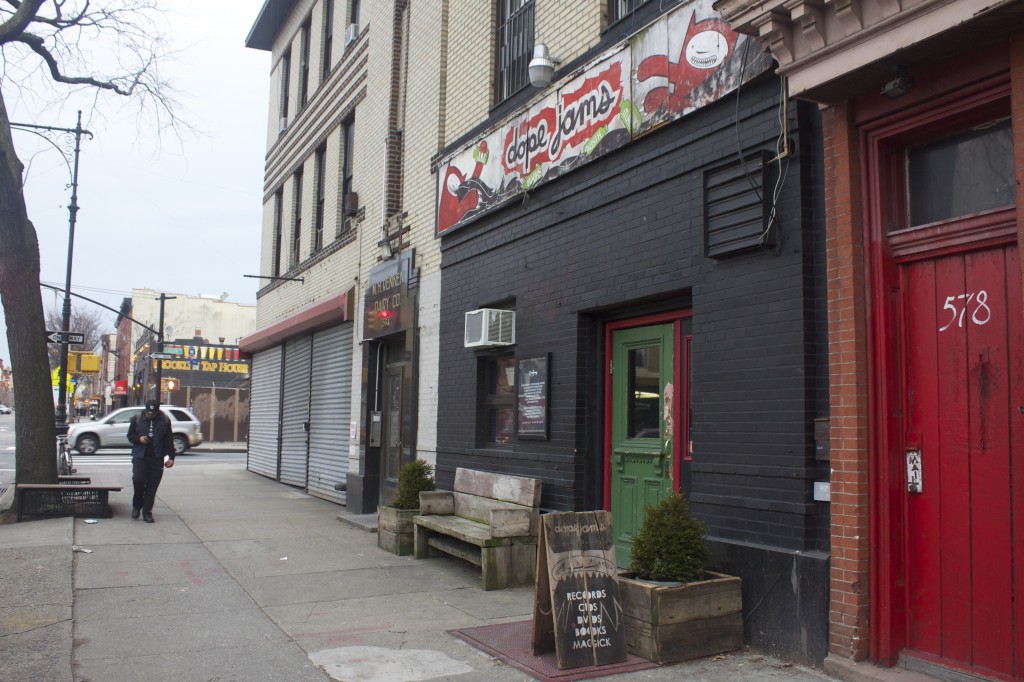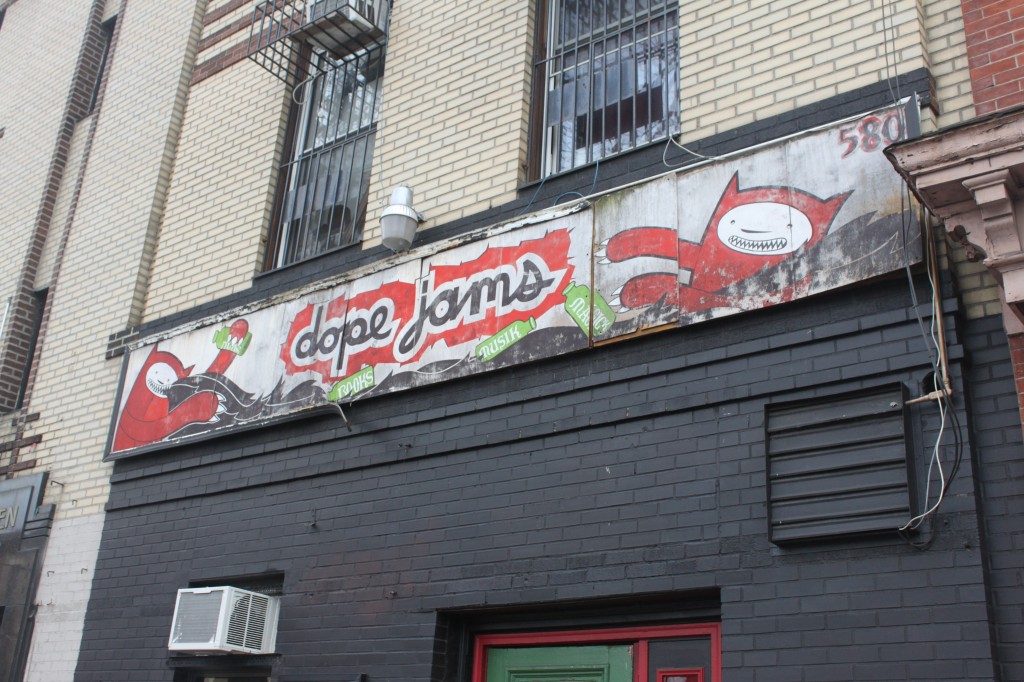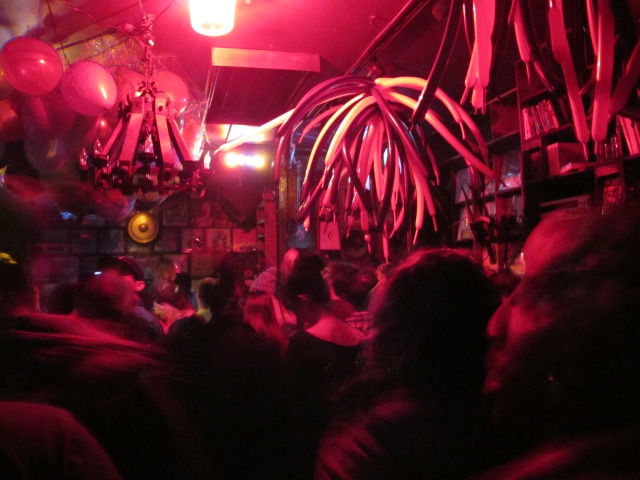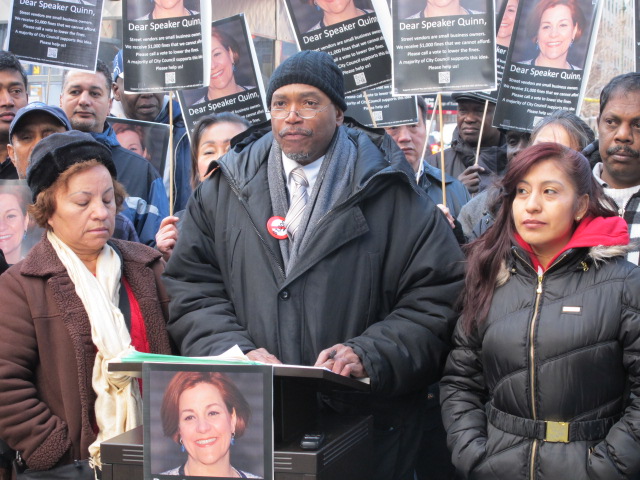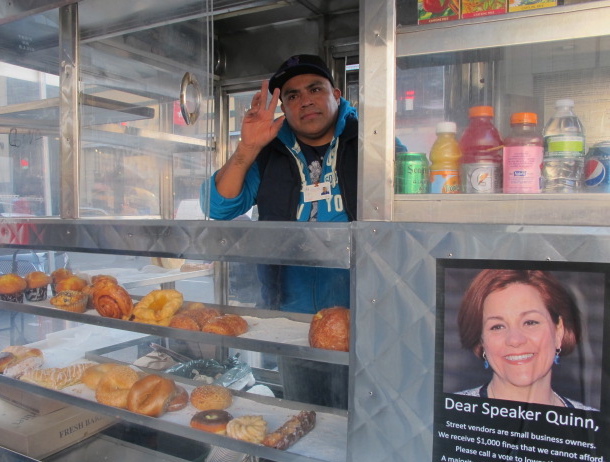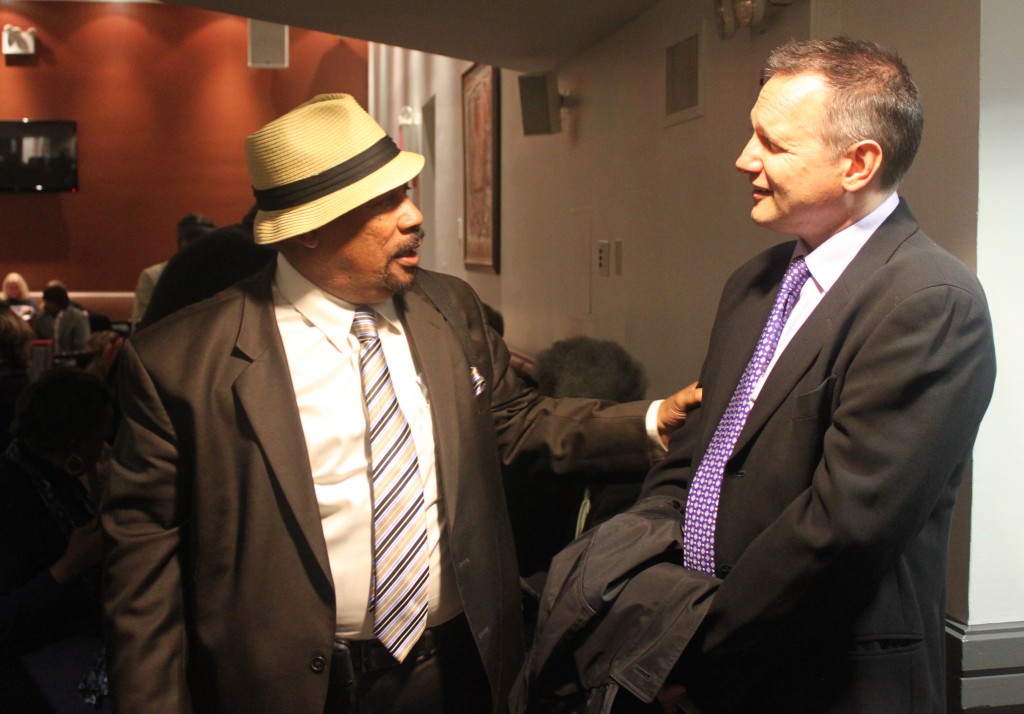
628 and 626 Cole Street, San Francisco, in Aug. 2013. My roommates and I lived in the first-floor apartment, through the door on the right. (Photo by Philippe Theise)
It was late 2013, and San Francisco was having a media moment. In the New Yorker, Nathan Heller wrote about tech investors and app designers engaged in a wealth-conscious party. On the front page of the New York Times, Erica Goode and Claire Cain Miller described a city where middle and working class tenants faced great difficulty holding onto their apartments, let alone competing for new ones. The boom culture comes about thirteen years after the dot-com bubble burst, when I was living with college friends in a single occupancy hotel in Hayes Valley. One of us moved into the first floor of a house at 626 Cole Street, just two blocks from Golden Gate Park, and when a room opened up in May 2001, I followed him.
The apartment had five rooms off a long hallway that led to the kitchen, a small back room, and outdoor stairs to the backyard and a second-floor unit. Paul often slept in the spacious front room with the bay window, unless he was visiting his parents in Philadelphia or housesitting for a friend. He earned an English degree from Penn after serving his tour, and he liked Camus. Emily lived in the next room and waited tables at Martin Mack’s, an Irish bar down Haight. Someone drew her portrait, and our upstairs neighbor, a recovering heroin addict also named Paul, printed it on tie-dye shirts he sold at the Haight Street Fair. Sam and Paul shared the smaller, mid-hallway room. Sam left college a few credits short of a Spanish degree and loved The Clash, and Sol sometimes brought his Stevie Ray Vaughn model Fender out of the case to jam. Along with Paul, the ex-ranger, Sam and Sol worked for Tonka, the moving company that gave me occasional shifts that summer.
I still don’t know much about Katie. In one of her Facebook photos, she’s looking down impassively at the camera like a mid-seventies rock god, and in another, the Jeepster tattoo beneath her neck extends above the top of an Ozzy Osbourne tank. She lived in the large room that overlooked the yard, where she had a rack full of punky shoes, and she worked as a dispatcher at a messenger company. She told us that Lars Frederiksen, the lead guitarist in SF punk heroes Rancid, had attended her birthday dinner. She was nineteen.
All the rooms were bedrooms, even the back one. It fit a compact couch and, at one point, three people.
Except for Emily, we didn’t wear our hair long. We didn’t attend drum circles in the park or volunteer to cook for Food Not Bombs. But we did talk. Sam slept on a foam camping pad, and one day, when Sol encroached on that slim rectangular space, Sam lectured him on “the one capitalist” thing he wanted for himself. Standing in his kitchen upstairs, Paul said that sobriety was a stonier trip than any of the junk he used to shoot. Our roommate Paul recalled a conversation with high school friends during the Reagan years about dialing out a suspected communist, and then discovering Howard Zinn years later. Elizabeth, a friend from Montana, cooked us a vegetable stew when we ran out of money. We pondered the obfuscating curves in the wrought-iron gate between our front steps and the street.
On the stoop, Sam said that something had happened to us when we were young, and that we had started to untangle it in the light of adulthood.
We had these moments and conversations in the Haight. Near the gutter punks who congregated by the McDonald’s at the corner of Stanyan. Amidst the other young people asking for food and change. Close to Mexican restaurants, record stores, head shops, and souvenir merchants selling rock history on colorful piles of heavy cotton tees. Close even to the basketball court on the Panhandle, the stretch of park that saw concerts in the sixties. The fog streamed down the street in the evenings, and the air felt damp in the house. I loved to borrow Sol’s red tweed Woolrich coat when he let me.
“Help an old hippie on Haight Street,” said a tall, cheerful man to passersby one night.
*

A distant view of the Golden Gate Bridge from near the top of Buena Vista Park, just a few blocks from the intersection of Haight and Ashbury Streets, in San Francisco. (Photo by Philippe Theise)
Before the hippies came the students. In the early 1960s, the Haight-Ashbury district’s declining Victorian homes provided low-budget housing for students at San Francisco State. Cafés numbered few, and restaurants numbered none, but public transportation ran through the neighborhood and it stood on the edge of the park. Some State students dressed in vintage clothing to match the period architecture. Histories of the era cite two September 6, 1965 articles in the San Francisco Examiner, “A New Paradise for the Beatniks” and “Hip New Hangout — The Blue Unicorn,” both with vivid leads describing mellow and sylphlike young people, as milestones in the growth of the area. The owner of the Unicorn, a coffee shop near the Panhandle, espoused “a striving for realization of one’s relationship to life and other people….”, a message he printed on leaflets.
That general goal comes up again and again in documentation of the period. Bob Weir, the rhythm guitarist for the Grateful Dead, claims that drugs did not create the efflorescence that followed the Examiner articles. “The bulk of what was happening in the summer of love was the exchange of ideas and attitudes and feelings,” he writes in his introduction to journalist Charles Perry’s “The Haight-Ashbury: A History,” and he identifies San Francisco’s arts- and lefty-friendly milieu as the movement’s true soil. But in the PBS Documentary “Summer of Love,” which focuses on the festivity and apprehension of 1967 and the gross letdown of 1968, San Francisco Chronicle music journalist Joel Selvin claims that LSD was “a fundamental building block in a new way of thinking,” and another subject admits that “we really thought that drugs were going to change the world.”
Media attention transformed the district as much as any chemical. Ralph Gleason, a jazz writer for the San Francisco Examiner, started covering the rock concerts in the city and eventually co-founded Rolling Stone. National magazines published stories and networks aired segments. In the PBS documentary, a woman from Boston talks about seeing pictures of hippies in her hometown newspaper and feeling the pull of San Francisco. Thousands of well-intentioned young adults arrived in 1967, and so did unabashed psychedelics and teen runaways. Didion wrote a little about the first group and plenty about the others. Painting the scene as a symptom of societal nonadhesion, she spoke with acid trippers, social activists, inexpressive children, a drug dealer, a cop, a psychiatrist, and she observed a five-year old whose mother gave her LSD. Where some saw promise, Didion saw intellectual blight. By the end of the sixties, heroin use in the Haight-Ashbury area increased, and businesses failed as people left. The bloom went bust.
Over thirty years later, as another local summer approached fall, Katie told me that she had spent the rent money we had given her in bars. I immediately empathized. Excessive drinking or drug use didn’t appeal to me, but excessive sugar intake did: devouring vegan cookies helped me smother important questions in the equivalent of gastrointestinal cement. Some of us smoked pot, acid made at least one appearance that summer, and sometimes our upstairs neighbor had guests who were also attempting to stay clean. This was still San Francisco: drug use and addiction ran in the streets like sluicing water in Paris.
At the house meeting, we sat in Katie’s room while she told us that it wouldn’t happen again and that she couldn’t sell her new bike to make up for the spent funds. I was already planning to move home, and Katie said she knew a couple that desperately needed a bed. “I’m interested in doing the right thing,” Sam said.
Years later, his ex-girlfriend told me about the fire.
*
My first slice of vegan cake came at a restaurant on Market Street devoted to the Indian spiritual entrepreneur, Sri Chinmoy. An alternative grocery store in Hayes Valley sold soy-based ice cream and dairy-free pumpkin pies, and the bodega nearest the hotel stocked sweetened corn puff cereal with no preservatives.
Having known various living arrangements, I can vouch that nothing compares to a single occupancy hotel for immoderate ingestion and private recovery.
After watching Neil Young and Crazy Horse stomp through “Cinnamon Girl” at the Warfield, I told Sam about my problem. But I never brought it up with him again.
Once I moved to Cole Street, the markets of Upper Haight served my needs. The Cala supermarket on Stanyan Street had a bulk bin of crystallized ginger in a corner, away from supervision. After I bought several rich desserts from a smaller grocer on Haight, the woman at the register took notice.
“You’re really going for it,” she said.
Orion, a Texan who worked at Tonka, brought me home a desk, but I don’t remember writing more than a letter on it. Writing required sitting, and if I sat, I would notice that I wanted something sweet to eat. So I biked up hills and ran to the ocean and moved furniture and wrote almost nothing.
Sol thought it was all in the way I looked at it. Emily put her arm around me when I told her.
On the morning of September 11, I woke up in my dark room with a digestive system full of fig cookies. I called my Dad for something, and he told me what had happened. I walked into the front room and found Paul sitting in front of a small TV. On one of our moves, he thanked our client, a Vietnam veteran, for his service, and said that America had been off its rocker.
“I thought the world was better than this,” he said.
I think he also said it changed everything.
*
Most of us had come from the northeast. I learned about the progressive activism in Northern California while volunteering in Boston for Ralph Nader’s presidential campaign. Paul’s friends founded Tonka’s first incarnation in Philadelphia. And Sol was born on the Farm, the Tennessee commune that emerged from the cross-country bus trip of a group of Bay Area hippies. He spent his teenage years in southern New Hampshire, where the response to his countercultural origin got him thinking about moving west.
“I was always this freak of nature hippie,” he said over the phone in late November, back in New Hampshire, with his eight-month old daughter, Rosie, burbling in the background. “I wanted to go somewhere that was a little more liberal and cultural.”
We might have lived in the Mission, the neighborhood where white and Latino artists and activists lived amidst a working class Latino population, but we weren’t organized enough for sustained creative or political engagement. Our friend Tonian curated exhibitions at an art gallery and dated a local rock star. She lived in the Mission. We belonged on the orphan Haight. And we were lucky to find a place.
In her book of collected photographs, “San Francisco’s Haight-Ashbury,” Katherine Powell Cohen writes that “young people” had a harder time finding affordable housing in the area in the 1990s. Cohen’s observation also applies to the Mission, where Heller visited a tech-friendly hangout called The Sub and Goode and Cain-Miller interviewed Latino residents protesting gentrification. The dot-com collapse tempered San Francisco’s rental prices—as one commenter on an SF blog characterized the mid-2000s, “rents dropped some, but the big deal was that you could actually FIND a place”—but the current tech boom has pushed prices past the prohibitive to the absurd: in December 2012, the median asking price for an apartment hit $3,100 per month. Working class families that cannot find homes have far greater problems than people drawn to and rebuffed by the residual magic of an imagined Aquarian age. But what happens when hippies can’t live on Haight Street?
In August, on my first walk up the street in twelve years, I met Teri Tencer-Cutler, and I thought she might know. A thin, spry woman whose frizzy gray hair ends in purple tips, she works as a case manager at the Haight Street Referral Center, where scruffy travelers and other homeless youth come for food, rest, medical care, and help finding jobs and places to live. On the day I visited, a young man lay awake on one couch, and a teen with short, spiky hair sat open-mouthed and asleep on another. An array of cardboard appeals covered part of a wall. “Begging sucks. Compassion is better”; “Broke, love sick and drifting”; “It burns when I pee.” Someone tended a pot on a stove.
A native Angeleno, Tencer-Cutler moved to a house in the Richmond district, just northwest of the Haight, in 1975. “I was one of the ones who came looking for the summer of love,” she said. She was also looking for an education: after failing out of college and following the Dead with a friend, she completed a year at City College of San Francisco—an institution that charges in-state students $46 per credit but could lose its accreditation next July—and earned a BA in developmental psychology at San Francisco State. Her mid-seventies migration coincided with a trend: Cohen writes that after hippie residents left a deteriorating neighborhood in the late sixties, their fondness for the spirit of ’66 and ’67 and the area’s still-standing Victorian houses effected a partial homecoming in that pre-bicentennial year.
Tencer-Cutler moved to Connecticut with her husband in 1982, where she eventually worked as a child and adolescent psychotherapist. When he developed Parkinson’s disease, the couple decided to move back to San Francisco, and found a two-bedroom apartment in the Haight for $3,500 a month in the fall of 2011.
She thinks that the residents who arrived in a different era disdain the latter-day travellers who show up today.
“A lot of people have forgotten [that] ‘I was the homeless, I was that person,’” she said.
But the original hippies don’t just dislike their unwashed descendants, some of whom are headed towards picking jobs in the marijuana fields up the coast. They also resent the cleaner-cut tech workers who have driven up local housing costs and tend not to participate in community initiatives, she later told me over the phone.
With a late summer breeze audible in the background, Tencer-Cutler described how easily she moved to the city in ’75, when she paid $85 or $90 for her room. The young people she works with today still want to find a place in the Haight—some of them follow the musical offshoots of the Dead, whose members once lived at 710 Ashbury near Waller Street—but she has yet to meet a group of them who succeed.
“Reality hits them. They can’t make it here anymore. The only ones who can make it are the ones working for the dotcom companies.”

Private commuter buses, including one for Google employees, pass by the corner of Haight and Cole Streets in Aug. 2013. Anti-gentrification protesters blocked passage of such buses in the Mission District and in Oakland in December. (Photo by Philippe Theise)
But something beyond prices and procedures—Tencer-Cutler and her husband faced requests for credit checks, references, and bank account information when they tried, and failed, to find a less expensive apartment in the neighborhood earlier this year—also thwarts the seekers, stoners, and other American beauties who make their way to the enchanted heights beside Golden Gate Park. If you came to San Francisco in the sixties or seventies, she said, you were likely to find a place to crash. But things shifted around 1981, when the AIDS crisis emerged.
“People are afraid of each other now. I don’t see the camaraderie that I saw when I was younger,” she said.
But sometimes, the old connections do matter. When she applied to be a case manager at Larkin Street Youth Services, the organization that administers the referral center, she noticed that the other applicants were into punk. Tencer-Cutler told her interviewer that she loved the Dead, and got an offer to work on Haight.
“Being an old deadhead finally paid off,” she said. “I always tell my mother that.”
After I met her in August, I kept walking up Haight Street towards the park. I turned left at Frank’s Haight & Cole Liquors, where I called my parents from the pay phone before getting a cell, and saw the house. Two stories, with a spotless sea foam façade. Its bay windows undulated along with its neighbors’, and its front entrance columns, steps, and tall iron gate also blended in. A guy in a black t-shirt answered the doorbell and said he didn’t have time to talk. A regular at the café across the street told me that the firefighters cut a hole in the floor on the morning of the blaze.
*
Over 100 firefighters arrived at the house in the early morning of February 21, 2002. The first floor inhabitants got out unharmed and received help from the Red Cross. The Chronicle reporter wrote that Anatole Geiche, the landlord I remember as nebbish and helpful, said that he “saw some anti-Russian graffiti” in the burned building, and that someone who didn’t like him had committed arson. He also admitted to doing maintenance in a vacant upstairs unit the night before the flames. The SF Fire Department redacted Geiche’s name and address from its incident report, but the investigator who wrote it concluded that “this fire was of an incendiary nature.”
Over the phone, Sol told me that work slowed down after Sept. 11, and that he, Sam, and Paul couldn’t earn enough to make the rent. He decided to move out, put his stuff into Tonka’s warehouse, and flew to New Hampshire for a visit on Feb. 20.
When he called Katie to ask about the cell phone he left behind, he said, her voice was shaking. She later described waking up to the ceiling threatening to cave in.
Sol said he returned to San Francisco and found Geiche selling undamaged items from the house in a kind of macabre sidewalk sale. Various neighbors recall that 626-628 Cole Street stood boarded up for years. Property records online show that it sold for $900,000 in 2008, up from $510,000 in 1990.
Sol left San Francisco for good in 2005, and decided to stay in New Hampshire after dealing with a mental illness. He married a woman with a black belt in Taekwondo whose parents operate a martial arts school in the next town over from Henniker, his teenage home. When we lived together on Cole, Sol trained at a dojo in the South of Market neighborhood, and he and Paul watched videos of Thai kickboxers. He sees finding a sensei and starting a family as part of his circuit out west and back.
“A lot of what I was trying to do was a spiritual journey, cause I’m pretty heavily into Buddhist meditation,” he told me on Thanksgiving weekend. “I feel like I did kind of place my trust in a higher power, [and] I got my dream in the martial arts, I figured out what was wrong with me.”
But he also dreams of San Francisco.
“Sometimes I’ll be trying to find the place I lived,” he said. “It’s like I’m transported there, I can feel the streets and the buildings. I have a lot of them.”
I asked him what we could have done differently on Cole Street. He mentioned having a communal living space, “something where we were all connected.”
“We weren’t working together,” he said. “It would have been nice if we all made dinners and did chores and volunteered our time.”
We met in the hallway, the kitchen, our rooms, and on the stoop. Rarely altogether. One time, Katie walked squinting into the front room, like a beetle with bedhead, after we had taken ecstasy.
“The love bug,” Sam uttered.
After the house burned, Sol lived in what he described as a superintendent’s room near Lower Haight. Our old roommates had mostly left. He said he “could never really nail anybody down to be a solid friend.”
“I think that’s the thing that I was really lacking in my life out there,” he said. “There are so many people that come and go in San Francisco.”
But for the tech workers, current reports describe more departures than arrivals.
*

The YMCA in Greenpoint, Brooklyn. Above the cardio machines and weight-lifting stations, single- and double-occupancy rooms house travelers, tourists, and the needy. (Photo by Philippe Theise)
What makes a place home? Almost nine years after leaving San Francisco, I was trying to move back to Greenpoint, Brooklyn, a former navvy of a riverfront neighborhood experiencing its own gentrification. The combination of the daylight on old brick apartment and factory buildings and the lack of a direct train to Manhattan still gives it a quiet, holy cast. A lumpy twin bed at the Greenpoint YMCA costs $50 a night, and for a few days at a time I would look for a permanent room before boarding the bus back to my parents’ condo in Boston.
After one fruitless stretch, I packed my bags and checked out. I was sitting on a bench in the lobby while members came in through the doors on Meserole Avenue, the afternoon sunlight behind them. The thought of the hump to Port Authority and the solitary ride home made me more tired than I already was. And then Sophia walked in, and asked if I could arrange a review of her fiancée’s film in the local paper. And then I saw Josh, my ornery former roommate, who had recently graduated from near-perennial status as a master’s candidate in library science.
“I know I wear a scowl like some people wear sweaters,” he once wrote to me.
Sitting with my bags, talking with my friends, I realized that I would surrender to the feeling of wanting to stay. It didn’t make a lot of sense to pay $50 for another night, but what, in the end, makes sense about being in the places we love? The woman at the desk gave me another room with a TV and a large bed with a shiny burgundy comforter. In the dim light, I sat down and realized that I wanted to die here, in Greenpoint, my neighborhood of light, friends and dreams.
Recently, while walking east on Commercial Street towards the Pulaski Bridge into Queens, I saw the cobblestoned sidewalk in front of No. 95, a three-story building that houses the offices of The Brooklyn Rail, a thick monthly devoted to art and politics. Discolored taupe brick covered the upper two floors of the building, but a whitish red paving ran around the tall windows on the first. The ruddy façade surrounded Glasserie, an upscale Middle Eastern restaurant that opened in June, as well as the local outpost of a popular ice cream shop.
A man wearing khakis and a tie walked toward an old Mercedes sedan parked in front of the entrance to the building’s courtyard. The car was taupe, too, and I commented on the automotive and architectural coincidence. The man introduced himself as the building manager, and we talked about the noise from recent construction in the area, and about developers’ plans to erect tall residential buildings on a lot at 77 Commercial, near a larger site where another group plans to erect ten towers along the water.
He told me that the new red bricks around Glasserie were selected to preserve the character of the Brooklyn industrial neighborhood. And that they came from Boston and Connecticut.

Red and bricks from Boston and Connecticut surround the windows of Glasserie, a Middle Eastern restaurant, and the Brooklyn Ice Cream Factory on Commercial Street in Greenpoint. (Photo by Philippe Theise)











